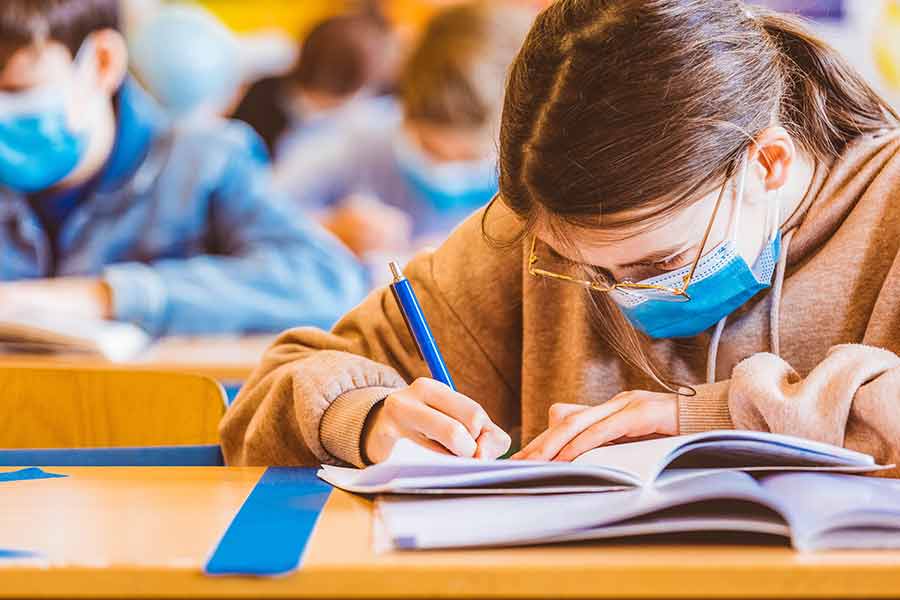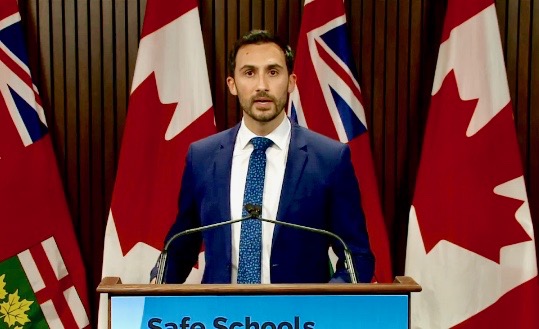THORNHILL – Provincial education minister Stephen Lecce was joined by the province’s top doctor Kieran Moore and others on Aug. 4 to announce funding for ventilation improvements in schools and to provide further insight on back-to-school guidance.
The province released general guidance on Aug. 3 aimed at school boards and public health units, giving a sense of what a return to classrooms will look like this fall.
Beyond confirming an anticipated return to classrooms for Kindergarteners to high schoolers, the 29-page document revealed activities such as physical education and assemblies are permitted and outlines where and when to wear a mask, leaving local public health units and school boards to add nuance and details.
The plan’s overall focus is on practising public health measures, with an emphasis on outdoor activity.
Moore said yesterday the goal is to have a safe and lasting reopening of schools and he touted the effectiveness of masking, screening, hand hygiene, enhanced cleaning and distancing as being effective to ward off the virus.
“I really can’t envision or see any closure of any schools in Ontario,” Moore said at the time.
“I think we have to normalize COVID-19 for schools and have an approach that’s prudent, that’s cautious, but that realizes, ‘yep we’re gonna have a rise in cases,’ but we’re going to adhere to the best practices to minimize the spread and to keep our communities safe.”
Lecce announced $25 million for schools to add stand-alone high-efficiency particulate air (HEPA) filter units to school spaces. Around 20,000 units have been purchased by the province to be sent to school boards in need. Remaining funds will be distributed to boards to purchase their own additional units.
Schools will be able to publicly share information on what measures have been taken to improve ventilation.

(Metro Creative image)
Lecce also said yesterday’s guidance has since been amended to allow for high-contact sports, such as hockey and basketball in indoor settings.
“We would like to allow a broad-based participation in those sports knowing that we want to have as close to return to normal as we can …” Moore said of the change.
“It’s a risk reduction strategy; there’s never a complete risk elimination, but we think it’s prudent, we think it’s reasonable, and we certainly want our children to be able to participate in those sports.”
NDP official opposition education critic Marit Stiles told the Advertiser the province is scrambling last minute to come up with a plan laden with gaps and unanswered questions.
“We’ve all been waiting for months, months and months for this plan to come out; school’s coming back in five weeks and this is not the plan I was expecting,” Stiles said.
She criticized a lack of updated guidance for outbreaks, a lack of testing options and transparency on ventilation improvements, and no reduction in class sizes.
“We need some assurances about what the metrics are here. And I think the fact that the government seems to be just playing a bit of a waiting game here, I don’t understand it,” she said.
“I’m very concerned that they’re going to come out with something in the next few weeks that’s actually going to turn everything on its head.”
In an Aug. 3 interview with the Advertiser, WDGPH associate medical officer of health Matthew Tenenbaum said the plan had only recently landed on his desk.
But from a cursory look, he said it provided “high-level parameters” from the province on retaining common sense prevention measures.
Tenenbaum said while some areas of the plan provide guidance on masking and indoor versus outdoor activities, it also has other areas allowing for local public health units to work directly with school boards—and that’s going to be the focus of future conversations.
“We’re going to take this guidance now to our future meetings with school boards, talk about where the gaps are, where we can provide further clarification, where we can help them problem solve, how to operationalize the approaches in there,” Tenenbaum said.
“There certainly are areas where we can provide fuller advice that’s a bit more nuanced than what the provincial guidance has.”
Inevitably, Tenebaum said, there will be room for improvement.
“There’s always some further nuancing that comes up when these abstract plan exercises hit the real rubber of the road in reality,” he said.
“We want to make sure that we throw everything we have at the school setting to make sure it allows kids to learn safely.”
Wellington County’s public and Catholic school boards, collectively representing 83 elementary and 15 secondary schools with over 43,000 students, have said not much has changed in the guidelines from what schools were practising before moving online.
Wellington Catholic District School Board director of education Mike Glazier called the guidelines “transitional.”
“It does loosen some of the protocols that they’ve had in the past,” Glazier told the Advertiser.
“But we’ll continue to take a cautious approach through this year and work with public health, looking at our local context to determine what the best steps are,” Glazier added.
Upper Grand District School Board superintendent of education Gary Slater said the provincial guidelines provide “a good starting point” for September plans.
Officials from both school boards are consulting with public health on how to put guidelines into practise.
—With files from Paige Peacock




